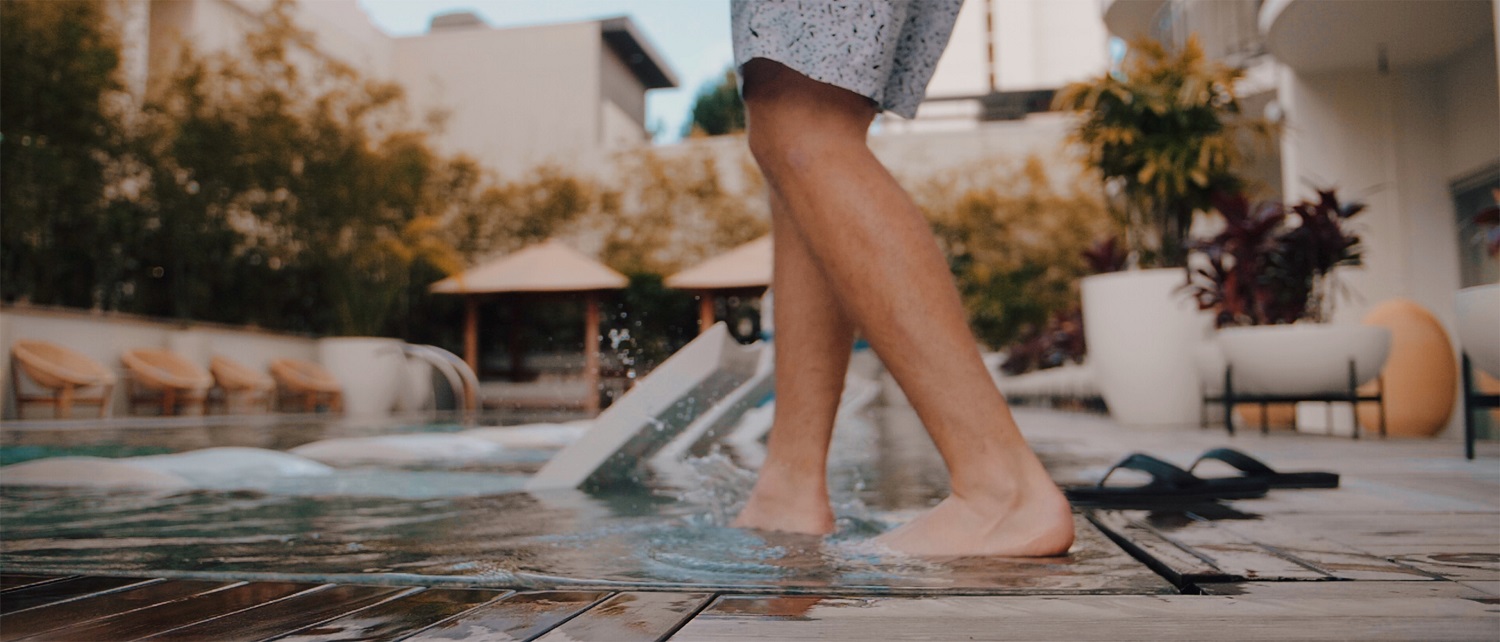
A Look at the Many Benefits of Aqua Therapy for Healing Sports Injuries
From a torn rotator cuff to a fractured foot, and worse, exercising after an injury is an important part of recovery. However, certain types of exercise can do more harm than good and end up exasperating the injury.
This is where hydrotherapy comes in. Instead of risking further injury with the strain of gravity during exercises on land, you can enjoy a comfortable, buoyant pool to reduce pain, gain strength, and heal your injury.
There are many benefits to using water therapy for treating injuries, along with many useful pool accessories to help with the healing process. Here’s a look.
Read More: Hydrotherapy Techniques You Can Enjoy at Home
What Is Water Therapy?
Water therapy,—also known as aquatic therapy, hydrotherapy, swim therapy, and aqua therapy—is a form of physical therapy that takes place in a warm pool.
While you can benefit from exercising in any pool, pools used for hydrotherapy are usually heated (around 35˚C), so you can relax in the water instead of tensing up in cold water. And you can enjoy the benefits of increased circulation and pain relief that heated water provides.
Hydrotherapy pools are also easily accessible and rectangular with varying depths to allow for walking in the pool along with deep-water exercises.
Hydrotherapy ranges in intensity from intense exercise sessions to simply floating or sitting in warm water (e.g., in a hot tub) to relax and benefit from the heated water.
Read More: Hot Tubs, Spas… What’s the Difference?
Since water is buoyant, exercises in water place less strain on joints, muscles, and bones. So it is safer to exercise in water when you are trying to heal injuries.
What Types of Injuries Can Benefit From Water Therapy?
Hydrotherapy can treat a wide range of physical injuries, including soft tissue and bone injuries, along with neuromuscular conditions.
Here are the many types of injuries that can benefit from water therapy:
- Arthritis—osteoarthritis and rheumatoid arthritis
- Bruising and swelling
- Back pain
- Back or spinal injuries
- Musculoskeletal conditions—such as ankle sprains, groin sprains, and frozen shoulder
- Following surgery for conditions such as ACL reconstruction, knee replacement, and hip replacement
- Fibromyalgia
- Neurological conditions including Muscular Dystrophy, Cerebral Palsy, Multiple Sclerosis, and Parkinson’s Disease
- Strokes or head injuries
What Are the Main Benefits of Water Therapy?
Water therapy provides many important benefits for healing a sports injury, such as:
- Pain relief
- Reduced muscle spasms
- Increased range of motion for joints
- Strengthening of weak muscles
- Increased circulation
- Improved balance and coordination
- Re-education of paralyzed muscles
Here are the main advantages of water therapy for sports injuries:
Buoyancy
The buoyancy of water takes the weight off your body, which means less impact and strain are placed on your body during exercises.
This buoyancy makes movements and exercises underwater easier and lets you perform some movements that you otherwise wouldn’t be able to on land, especially if you’re injured.
Resistance
Water is denser than air, so it provides more resistance—and in all directions—during exercises and without the full weight of your body. And when combined with the buoyancy of water, you can perform functional exercises while improving range of motion and strength.
Increased Circulation
The heat and weight of water (hydrostatic pressure) increases blood circulation and flexibility while decreasing swelling. Increased blood circulation can also help heal injuries and reduce inflammation.
Pain Relief
Hydrotherapy is known for relieving pain and symptoms of many disorders. For example, aqua therapy can help those with osteoarthritis reduce joint pain and improve balance, function, and mobility.
It can also lead to symptom improvements and pain relief for those who have suffered from a stroke, are pre- or post-surgery, and those with:
- Post-op ACL tears
- Fibromyalgia
- Muscle imbalances
- Chronic or acute injuries
Mood Booster
Hydrotherapy can help you feel better while recovering from an injury, not only physically, but emotionally and mentally as well.
Instead of being stuck inside while nursing an injury and feeling down, you can get out of the house and into a pool, becoming stronger, happier, and more confident with time.
Water therapy can significantly improve your quality of life while you’re working towards healing an injury. And you can gain a positive outlook, being motivated to heal faster.
Safe
Exercising in water is overall much safer than exercising on land when you have an injury. While on land, you may fear further exasperating your injury, e.g., from a fall while exercising. But when you’re in the water, the water’s resistance helps you maintain balance while reducing the risk of further injury.
What Kind of Therapy Accessories Are Available for Your Pool?
Here are some of the many swimming pool accessories that are used in water therapy for improving both safety and exercises:
Swim Bars
Swim bars look like barbells, but instead of having heavy metal weights on each end, these bars have floatation devices. Swim bars help increase safety during pool therapy by improving balance and stability. And they also increase muscle tone and flexibility.
Swim Belts
Swim belts have a strap with multiple floating devices that wraps around your waist to help keep you afloat while also providing some weight resistance, which improves safety during aqua therapy sessions.
Pull Buoys
Pull buoys are smooth, contoured foam pieces that provide lower body buoyancy during water therapy and exercises.
Hand Bars
Hand bars look like dumbbells but with floatation devices on each end, helping to support muscle rehabilitation and upper body workouts in the pool.
Swim Platforms
Swim platforms are used for safe swim training, aquatic exercise, and water therapy.
Flotation Collars
Floatation collars improve safety during water therapy since these collars help keep your head above water during pool exercises.
Swim Rings
Swim rings help keep your head, arms, chest, and upper body afloat by supporting you under your arms. These rings make aquatic exercises safer, especially when working on your lower body.
Body Sling
A body sling supports your head and your torso, keeping your upper body afloat while in the water.
Whether you’re suffering from muscle, bone, or tendon injuries, you can benefit from hydrotherapy from the comfort of a pool. Pool therapy will help you heal faster without the worry of further hurting yourself and with the added relaxation of floating in warm water.

Bert Minor has been a part of the landscaping business for nearly twenty years and has gained an excellent reputation as an innovative and creative designer. In fact, several of his designs and projects have been featured in industry supplier magazines. An active and contributing member of the industry, Bert sat on various boards including the Ottawa Chapter of Landscape Ontario and the Landscape Ontario Provincial Construction Committee. Bert also contributed technical articles published in the Canadian National Landscape Association magazine. With a relentless pursuit of knowledge, Bert has attained several industry certificates in landscape design, landscape construction and with the PHTCC—Pool and Hot Tub Council Canada. Prior to joining the landscaping industry, Bert spent several years in management in the services sector primarily in a customer advocate role. His honesty and integrity and his ability to build and develop strong relationships with clients reflects that.
